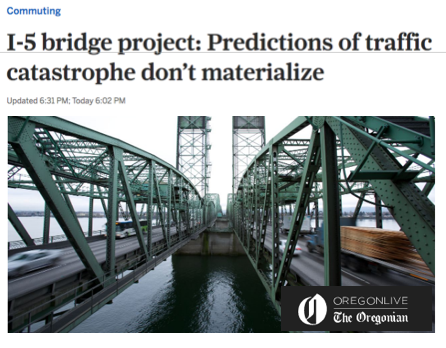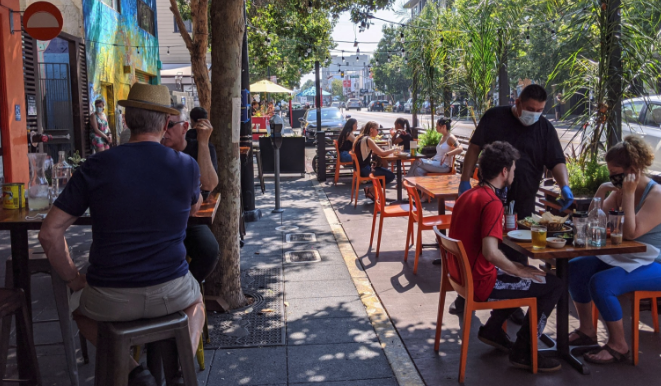What City Observatory did this week
1. Carmaggedon never comes, Portland edition. It’s a favored myth that any reduction in road capacity will automatically trigger gridlock, and highway engineers regularly inveigh against reallocating road capacity to promote safety or facilitate other users. But real world experience with abrupt and significant reductions in road capacity shows that traffic declines in response. Portland just closed half of its key I-5 freeway bridge for a week, and forecasts of gridlock and four-mile long queues simply didn’t occur. Portland’s Oregonian reported that “forecasts calling for a nightmarish region-wide traffic catastrophe failed to materialize … travel patterns largely followed the normal cycle.”
The reason? Travelers rapidly change their behavior in response to changes in road capacity, as many road users have choice about when, whether, by what route and how they travel. The fact that carmaggedon never comes should remind us of the hollow and self-serving nature of highway engineer forecasts.
2. Gentrification’s big disconnect. We’re pleased to publish this guest commentary from Akron’s Jason Segedy, who stresses the profound disparity between the plight of low income neighborhoods in most of the nation’s cities and exaggerated concerns about the adverse effects of new investment, aka “gentrification.”
Must read
1. Matt Yglesias: Much more housing. In the wake of World War II, many feared that peace would cause the US to lapse back into the doldrums of the Great Recession. That fear was a major impetus to big federal subsidies to housing, highways (and sprawl). But the postwar housing boom did help power the economy, and Vox’s Matt Yglesias argues its time for another dose of this medicine:
A combination of rental assistance for consumers, capital funding for affordable housing, and regulatory relief for builders of all kinds could unleash a massive boom in new construction, creating countless blue-collar jobs and laying the foundation for a new era of inclusive prosperity.
Yglesias claims that we have a shortage of housing, but in our view, it’s more accurate to say we have a maldistribution of housing: too much housing in the hands of empty-nesters in suburbs, too little housing in prosperous cities and high-opportunity neighborhoods. Agree with Yglesias or not, this is a productive debate to be having.
2. A surge in biking, big data from Strava. Many dedicated cylcists use the Strava app to track their trips and measure their performance against other cyclists. With millions of trips in its database, Strava provides one indicator of the growth of cycling in cities across the US. Strava published some of this data, which show a significant uptick in cycling activity during the pandemic Here are the data for New York City.
Strava has compiled this aggregated data into a new web-based tool called “Metro” that lets planners track cycling data for specific locales.
3. Covid cuts a diagonal slice through cities and suburbs. The inimitable Johnny Sanphillippo of Granola Shotgun has one of his signature photo-laden essays about how commercial and public spaces in cities and suburbs are faring in the wake of the CoronaVirus. While many are quick to proclaim the end of cities, Sanphillippo argues that the effects aren’t simple and clear cut, and the pandemic is creating winners and losers in every geography.
There’s a lot of talk on the interwebs these days about the mass exodus from big cities. . . .. The migration of frightened people seeking safety in the hinterland…. But the reality is more nuanced than suburbanites or country folks grasp. We aren’t seeing the end of cities and the triumph of the outskirts. Instead we’re experiencing a complex patchwork of winners and losers everywhere.
Parks and other civic spaces in cities are flourishing as people look to social-distance while experiencing the public realm. In the suburbs, many big box stores, like WalMart and Home Depot still thrive, by much of the rest of retail, especially the small in-between stores that fill out malls and strip centers are being decimated.
New Knowledge
Electric cars won’t be enough to fight climate change, and pose their own problems.
One view of climate change–espoused by many highway departments–is that fighting climate change is simply a matter of electrifying the vehicle fleet. Just replace internal combustion engines with battery electric models, and voila, greenhouse gases disappear, with no need to change anyone’s travel patterns or land uses, and best of all, highway department’s can just keep building more roads, a kind of electric business as usual for them.
The trouble is, converting to an all electric fleet is a pipedream. A new study from the University of Toronto tackles the details of what such a transition would entail, and the results are daunting. The authors estimate that fighting climate change would require 90 percent of the vehicle fleet to be electrified by 2050, up from less than 3/10ths of one percent of all vehicles today. Not only is that not plausible, the most optimistic estimates suggest that the best we might do by then is get to 50 percent electric vehicles, but the massive ramp up of electrification has costs of its own.
The biggest one is that we’d need vastly more electricity–the author’s estimate that achieving 90 percent electrification would require about 41 percent more electric generation. Beyond that, that load (with its own peaking and geography) would put a massive strain on the power distribution system and would likely require considerable new infrastructure in both power generation and transmission. In addition, building that many electric cars and their batteries, entails significant environmental costs and the mining of scarce materials in many sensitive places.
Alexandre Milovanoff, I. Daniel Posen & Heather L. MacLean, Electrification of light-duty vehicle fleet alone will not meet mitigation targets, Nature Climate Change (2020).
In the News
Strongtowns featured our analysis of the overwrought predictions of Carmaggedon that traffic engineers use to scare the public in its article, “Carpocalypse Never?”



